|
IN 1981 PETER
MELLER REFERRED TO THE MANY CONTRADICTORY interpretations of Giorgione's
painting "The Three Philosophers"[1]
(figure 1) as a "vicious circle".
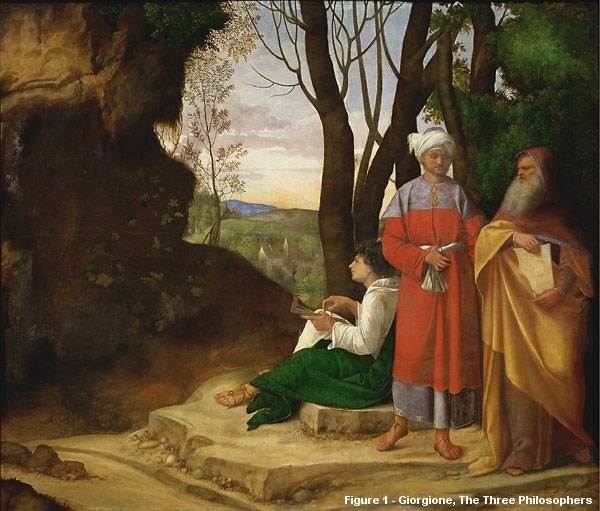
Only three years previously, Salvatore Settis
had surveyed the critical history of the painting in La "Tempesta"
Interpretata (1978), to reargue the case made two centuries earlier in 1783
that its three figures portrayed there were the "Three Magi".[2]
Meller reexamined its iconography from the clues offered by Marcantonio Michiel
in his celebrated note of 1525 written after seeing it in the house of Taddeo
Contarini in Venice: namely, "three philosophers. ..marvelously imitated rock.
..rays of the sun. ..landscape".[3]
and concluded that we are looking at Plato as metaphysician standing with two
pupils before his own metaphorical cave. If the images of bare and leafed trees,
ivy and fig, dark and light, represent original sin and resurrection, then we
might have "U tipico paesaggio moralizzato" in which the Platonic parable
prefigures Christianity.[4]
Support for the "Three Magi" identification has since been revived by E. H.
Gombrich in 1986, but in 1995 Simona Cohen argued cogently that the three
figures must represent the three great monotheistic religions: Judaism, Islam,
and Christianity.[5]
A difficulty with
in such theories is the "cave" assumption. Michiel did not refer to it as a
cave, after all, but a "rock:' and there is no evidence that it is more than
that, whether the rock has been eroded or quarried into its depicted shape.[6]
To some critics none of that matters:
But, for
Giorgione's purpose, the identification of all these figures seems
irrelevant. If
there is a theme in these pictures, it is the drama of all nature,
in which each
element-man, tree, rock, sky-plays an important part.[7]
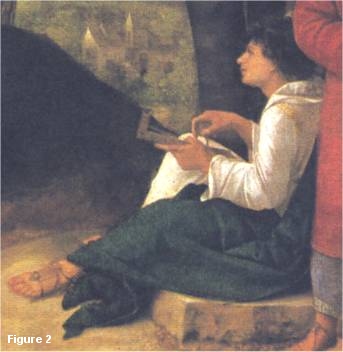 "The Three
Philosophers" is a complex work of art, so its solution could prove equally
complex. Giorgione has set the scene in some hills above a plain, on an
apparently quarried, stepped platform before a concave rock-face. From its
right-hand rim grows a young poplar, and scattered leaves of fig and ivy lie on
the ground. Behind stand two mature trees, one bare, one in full leaf. In the
plain below, a substantial building with a tower and a water-wheel appears
framed in the cleft marked by the rock and the trees. The sun sets softly over
the horizon. A mysterious source of light which seems not to be that sun
illuminates a glowing rectangle of light high up that east-facing rock.
"The Three
Philosophers" is a complex work of art, so its solution could prove equally
complex. Giorgione has set the scene in some hills above a plain, on an
apparently quarried, stepped platform before a concave rock-face. From its
right-hand rim grows a young poplar, and scattered leaves of fig and ivy lie on
the ground. Behind stand two mature trees, one bare, one in full leaf. In the
plain below, a substantial building with a tower and a water-wheel appears
framed in the cleft marked by the rock and the trees. The sun sets softly over
the horizon. A mysterious source of light which seems not to be that sun
illuminates a glowing rectangle of light high up that east-facing rock.
In the centre of
the painting sits a youthful,dark-haired man (figure 2) wearing an embroidered
dalmatic and holding a square and compasses. An architect or master-builder
perhaps. He seems to be looking intently at that same patch of light on the
rock-face.[8]
At the right, a
mature, full-bearded and cowled philosopher-figure[9]
(figure 3) is also showing obvious interest in that patch of light, but without
looking directly at it, displaying in his hands a chart containing zodiacal
symbols and letters: a word, possibly CELUS (sky) or CRISTO.[10]
The chart seems to possess a brilliance of its own (the light on the rock may
actually come from it), and its apparent thickness suggests a gold tablet or
foil. This "philosopher" seems to be the only one of the three actually
speaking.
The dress and
demeanor of the central figure with the turban (figure 4) suggests an
aristocratic Moslem.[11]
His pose is relaxed and passive, but expectant. Unlike the other two, he looks
not at the rock but at that figure on the right with the mysterious chart.
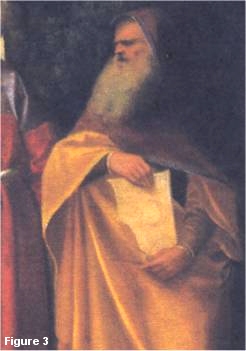 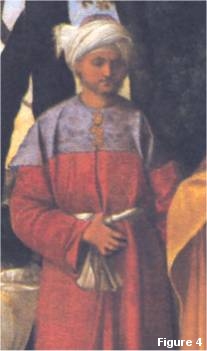
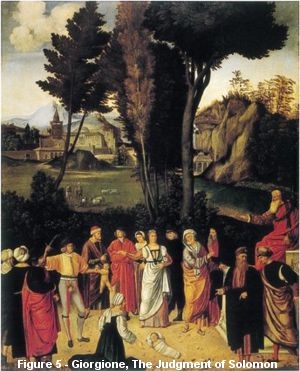 Let us suppose
that these three figures are the three builders of King Solomon's Temple in
Jerusalem; they are (right to left), Solomon himself, King Hiram of Tyre, and
Hiram the Master Craftsman of Tyre, the man seconded by Solomon to his grand
project.[12]
The features of the cowled philosopher-figure on the right concord with the King
Solomon (a figure apparently completed by another hand) in Giorgione's own
"Judgment of Solomon" (figure 5): there Solomon is elderly, full-bearded,
fully-robed (without a cowl), his expression one of deep concentration.[13]
In the background the artist has represented Solomon's temple with a spire and
dome.
Let us suppose
that these three figures are the three builders of King Solomon's Temple in
Jerusalem; they are (right to left), Solomon himself, King Hiram of Tyre, and
Hiram the Master Craftsman of Tyre, the man seconded by Solomon to his grand
project.[12]
The features of the cowled philosopher-figure on the right concord with the King
Solomon (a figure apparently completed by another hand) in Giorgione's own
"Judgment of Solomon" (figure 5): there Solomon is elderly, full-bearded,
fully-robed (without a cowl), his expression one of deep concentration.[13]
In the background the artist has represented Solomon's temple with a spire and
dome.
Biblical accounts
of Solomon's succession to the throne of his father David (as Bathsheeba's
second son) are given in 1 Kings: 1-15 to 2:10 and 1 Chronicles 29:26. David had
already established a royal sanctuary on Mount Moriah at Jerusalem, and to
Solomon as his heir fell the task of constructing a temple according to his
orders, worthy of the Lord (1 Chronicles 28) .Solomon's reputation as a
supremely wise and righteous ruler, the virtues he had prayed for (1 Kings
3:3-15), was later sullied by his lust and worship of false gods, and for that
he would be punished by God (1 Kings 11-12).
For the
construction of King Solomon's temple in Jerusalem we have three ancient
literary sources: 1 Kings 5:13-8:66, 1 Chronicles 2:1-7:22, and Flavius
Josephus' Jewish History 8-42-141. On King David's death, we read, King
Hiram of Tyre sent messengers to congratulate the successor to the throne of his
old friend. Solomon replied with a request for timber from Lebanon-cedar and
fir. Hiram obliged (1 Kings 5:1-7). Logs were cut then floated by sea to
Solomon's kingdom (1 Kings 5:9-10). In return, Solomon supplied Hiram with great
quantities of grain and oil (1 Kings 5:11). He dispatched 70,000 workmen to
carry building material, and 80,000 stonecutters to the mountains to
quarry and dress stone (1 Kings 5:15). Huge blocks were laid and squared for the
foundations (the construction is described in great detail in 1 Kings 6-7).
Then Solomon
brought the master-craftsman and specialist in the casting of bronze from Tyre,
Hiram Abi, the son of a widow of the tribe of Naphtali and a Tyrian father (1
Kings 7:13-14). He to do all of that work for Solomon's Temple: "qui, cum
venisset ad Regem Salomonem, fecit omne opus e ius". By the middle ages, this
Hiram was already invested with the role of master architect and project manager
for the Temple, responsible for all aspects of its design and construction. The
legend of "Hiram Abif" would be passed from the guilds (lodges) of masons of the
middle ages to the lodges of the Speculative masons and to Freemasonry as a
whole.[14]
Giorgione's seated figure holds square and compasses, and is dressed in an
aristocratic embroidered dalmatic. (Prior to final revisions to the painting, he
wore the tall cap of "un studioso.")[15]
He, then, would be Hiram Abi, engineer and architect.
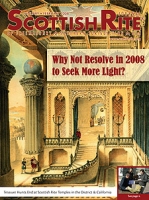 The Scottish Rite Journal is published bimonthly by the Supreme Council, 33°, Ancient and Accepted Scottish Rite of Freemasonry of the Southern Jurisdiction, United States of America, Washington, DC.
The Scottish Rite Journal is published bimonthly by the Supreme Council, 33°, Ancient and Accepted Scottish Rite of Freemasonry of the Southern Jurisdiction, United States of America, Washington, DC.
|
The Temple had
been a "powerful image in Isaiah's experience of the presence of God" (Isaiah 6:
1-6). In the New Testament it became a metaphor for the divinely-ordained
prefiguring of a Temple of God "not made with hands". The "Stone which the
builders rejected" (Psalms 117:22, Isaiah 28:16, etc.) expanded the
architectural metaphor, along with the idea of the Faithful as "living stones"
of the Temple (Galatians 2:9, Revelations 3:12). The Allegory of the Temple as
prefiguring the "Body of Christ" was developed by Church Fathers such as Origen,
Ambrose, Augustine, and Gregory the Great.[16]
Bede's homily De Templo[17]
reminds us of the etymologies of the names Solomon ("Peacemaker") and Hiram
("Living Exaltedly"). Solomon had chosen collaborators from the Gentiles (De
Templo, 148), and masons ofboth had hewn the stones for the Temple. Hiram might
also betaken, Bede continues (De Templo, 148-49), as representing those
temporal rulers who after conversion had helped the Church against heretics,
schismatics and pagans. Bede's commentary on Hiram Abi continues in this vein:
when he carried out Solomon's projects it was done "mysterii gratia" to
prefigure God's selection of the Gentiles as Ministers of his Word (De Templo,
197). His being a bronze worker was allegorically right, for bronze, like the
word, is lasting and far-resounding: "aeris namque metallum valde esse
durabile constat atque omnimodo sonorum" (De Templo, 198).
The middle figure,
elegantly and colorfully dressed as a noble Arab, would then be Hiram King of
Tyre. Having no technical responsibilities himself, he seems relaxed but
curious, his right thumb hooked over his sash as if awaiting some revelation
from the cowled figure on the right with the tablet or scroll. Giorgione casts
"Solomon" as a philosopher with an astrological chart and (like Hiram) a pair of
compasses. I Kings 4:29-34 characterize Solomon as a polymath, his wisdom being
the prayed-for gift of God ( I Kings 3: 9-15) as vast as the sands of the
shores. He was wiser than all the sages of the East and of Egypt (I Kings
4:30-31). He composed three thousand proverbs and one thousand five psalms.
(Later the Song of Songs, the Wisdom of Solomon, and Ecclesiastes would be
attributed to him as well.) He was a biologist, expert in trees and vines,
animals, birds, reptiles and fish. His wisdom brought many visitors to hear and
consult him (I Kings 4:32-34). According to the Jewish Antiquities of
Josephus, he investigated all nature scientifically, and knew charms against
demons (Jewish Antiquities, 8.44). Josephus attributed the foundation of
astronomy to the Hebrews (Jewish Antiquities, 1.3). By the middle ages the
traditions of Solomon's prodigious learning was extended even to the heavens, as
attested by a 910-line poem in Old French, "Le Lunaire Que Salemons Fist".
Solomon's lunarium was a table drawn up to guide his son Reboam in all he
did, day by day through the months of the year:[18]
Much he taught him
of far-away things, then opened to
him very well the
doctrines of the chief arts, and showed
him all the power
and courses of the moon, and its waxings
and wanings. Of
the moon he made a table that is most
valuable and
respected. It is called "Solomon's Table".
In those books of
the Bible attributed to Solomon, the sun is a pervasive image of beauty,
constancy and intelligence. Ecclesiastes refers frequently to the pain and
weariness of life "under the sun" (Ecclesiastes 1:3 et passim). The
famous exhortation "Remember now thy Creator in the days of thy youth" continues
(Ecclesiastes 12:2) "before the sun and the light and the moon and stars are
darkened". Solomon's bride (Song of Songs 6: 9) is "as fair as the moon, as
choice as the sun". His gift of Wisdom came as the "risen sun" (Song of Songs
5:6). A good woman is like the sun (Ecclesiastes 26:21), the holy man as
constant as the sun (Ecclesiastes 27:12). The sun itself is the "wonderful
vessel, work of the Most High".
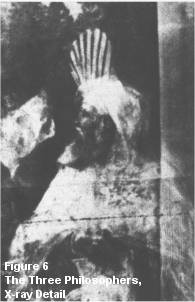 The overpainted
draft (pentimento) of the "Solomon" figure revealed by X-rays in 1932
seems to have been looking directly at the light on the rock, and wearing a tall
rayed crown, which Cohen sawas the "rays" of Moses.[19]
By the reading offered here, it was Solomon's royal crown. (figure 6) The fig
and ivy leaves scattered on the edge of the rock face would symbolize Solomon's
peaceable reign (I Kings 4:25 -ivy is used similarly in Jonah 4). Meller saw
these leaves as allusions to salvation and original sin.[20]
The overpainted
draft (pentimento) of the "Solomon" figure revealed by X-rays in 1932
seems to have been looking directly at the light on the rock, and wearing a tall
rayed crown, which Cohen sawas the "rays" of Moses.[19]
By the reading offered here, it was Solomon's royal crown. (figure 6) The fig
and ivy leaves scattered on the edge of the rock face would symbolize Solomon's
peaceable reign (I Kings 4:25 -ivy is used similarly in Jonah 4). Meller saw
these leaves as allusions to salvation and original sin.[20]
Compasses indicate
an astrologer or architect. In De Architectura (Editio Princeps:
Rome, 1486) Vitruvius was at pains to stress the learning and the native ability
required by the craft of architecture (his contemporary Horace required both for
the craft of verse): "Neither talent without discipline nor discipline without
talent can make a perfect craftsman" (De Architectura 1.3). The
disciplina of the architect included history, philosophy, music, medicine,
law, astronomy and the caeli rationes (De Architectura 1.3). He also had
to learn to use the rule (euthygramma) and compasses (circini).
Buildings must be sited "in strict accordance with the regions of the sky" (De
Architectura 1.4) to take advantage of the sun and climate (De
Architectura 1.4). Philosophy will ensure that the architect is not
adrogans, but rather aequus and fidelis, and free of avaritia
(De Architectura 1.6). The study of Medicine will teach the architect
about the inclinatio caeli (Greek climata) (De Architectura 1.10);
Astrologia, the motions of the sun, the seasons, the paths of the stars -without
which the sundial would be incomprehensible (De Architectura 1.10; 9.1).
Vitruvius also explains the principles of quarrying, dressing, curing of
building stone, and of estimating the quantities needed (De Architectura
2.7); the phases and risings of the moon (De Architectura 9.2) and the sun's
course through the zodiac (De Architectura 9.3).[21]
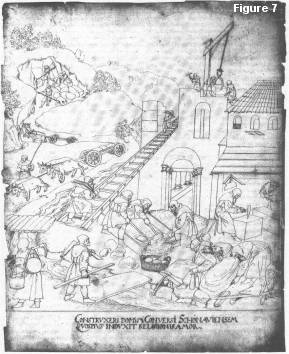 The setting of
Giorgione's "marvelously imitated rock" (Michiel) resembles a worked quarry,
like the quarry-landscape for his "Tramonto" which also shows a similar
rock-face (along with a water-filled pit, the lake of St. George's dragon).[22]
For the representation of an active quarry (figure 7) as part of a building
project see following sixteenth-century engraving of the construction of the
Abbey-Church of Schonau.[23]
The setting of
Giorgione's "marvelously imitated rock" (Michiel) resembles a worked quarry,
like the quarry-landscape for his "Tramonto" which also shows a similar
rock-face (along with a water-filled pit, the lake of St. George's dragon).[22]
For the representation of an active quarry (figure 7) as part of a building
project see following sixteenth-century engraving of the construction of the
Abbey-Church of Schonau.[23]
What is to be made
of Giorgione's large towered building with the water-wheel in the
plain below? It is unlikely to be either Solomon's Temple or palace, for both
were huge and richly constructed of cedar and costly stone; even the palace
measured 100 x 50 cubits, with a height of 30 cubits (I Kings 7: 1-11). In
Giorgione's "Judgment of Solomon"[24]
both Temple (as a basilica with dome) and Palace (with a spire) appear in the
background. In his original version of the "Three Philosophers" as revealed by
X-ray in 1932 the building appeared on a hill-top, not in a plain, and also
seemed to have a spire and a dome. In the revised version we have is a mill, but
what kind of mill? In 1544 Cardinal Bessarion saw water-wheels in Italy driving
saw-mills and blast-furnaces.[25]
They had been used from the middle ages to power brass foundries,[26]
forge hamrners,[27]
and stone-saws.[28]
Vitruvius had described their various applications in milling grain in Roman
times.[29]
Constructing the
Temple and palace required vast amounts of sawn lumber and dressed stone, and
Hiram Abi needed tons of copper and tin for bronze castings. Solomon had shipped
tons of grain and oil to Tyre (both of which in the Renaissance could have been
processed by water-power). Representing the Temple and palace originally high on
Mount Moriah would have made the riddle simpler than his patron intended.[30]
What then would
Giorgione's three "Temple-builders" have been doing together at a hill-quarry
outside Jerusalem at sunset? Two seem to be looking towards the patch of light
illuminating the rock-face, glowing from a mysterious unknown source or from the
foil or tablet inscribed with astrological symbols, symbols that may have
brought them to this spot for a revelation. The stone itself could relate to the
Temple, if it were the Biblical corner-stone (lapis angularis) which the
builders rejected. First mentioned in Psalm 118:22 and Isaiah 28:11, it
represented Israel. In the New Testament (1 Peter 2:1-9) the same stone has come
to represent Christ and Salvation:
So you will find
in scripture the words, Behold, I am setting down in
Sion a
corner-stone, chosen out and precious; those who believe in him
will not be
disappointed. Prized then, by you, the believers, he is something
other to those who
refuse belief; the stone which the builders rejected has
become the chief
stone in the corner, a stone to trip men's feet, a boulder
they stumble
against. They stumble over God's word, and refuse it belief; it
is their destiny.
Not so you; you are a chosen race, a royal priesthood, a
consecrated
nation, a people God means to have for himself; it is yours to
proclaim the
exploits of the God who has called you out of darkness into his
marvellous light.[31]
In Matthew 21:42,
Jesus, speaking in the Temple identifies himself as that Stone.
And Jesus said to
them, Have you never seen those words in the scriptures,
The very stone
which the builders rejected has become the chief stone at
the corner; this
is the Lord's doing, and it is marvellous in your eyes?
To the texts
associating Solomon with the images of sun and moon, one may add the Divina
Commedia. Canto X of Paradiso takes Dante past the first three
heavens beyond the shadow of the Earth -the Moon, Mercury, and Venus- to a
second group comprising the spheres of the Sun, Mars, Jupiter, and Saturn, as
abodes of the Saints. There within the fifth sun in the Heaven of the Sun dwells
Solomon (a figure alluded to three times by Dante, though never by name).[32]
Dante wrote (Paradiso, Canto
X, 109-14):
The fifth light,
which amongst us is most fair,
doth breathe from
such a love that all the world
down there
thirsteth to know the news of it;
within there is
the lofty mind, to which a wisdom
so profound was
granted, that, if the truth be
true, no second
ever rose to such full vision.[33]
In Dante's
Purgatorio, Canto XXX, 10-12, Solomon greeted Beatrice with his own words of
adoration from the Song of Solomon (4:8):
Anon one of them,
as if sent from heaven, "Veni
sponsa de Libano"
did shout thrice in song,
and all the others
after him.
Solomon was partly
rehabilitated in the Middle Ages by Hugh of St. Victor and St. Bernard through
interpretations of the Song of Solomon as prefiguring the mystical union betwixt
Christ and his church. The Wisdom of Solomon 7:7-8 also expresses a passionate
devotion to God-given Wisdom:
I prayed, and the
spirit of wisdom came upon me. This I valued more than
kingdom or throne;
I thought nothing of my riches in comparison.
The setting sun,
the square and compasses of Hiram Abi along with the compasses and astrological
chart of Solomon and (Wisdom, Knowledge, and Prophesy), the glowing Stone and
the fig-leaves and trees (Christ and Salvation) provide powerful images for "The
Three Philosophers". The dramatic figure of Solomon as philosopher-king,
astrologer, and Temple-builder provides a focus for Giorgione's allusions to the
Bible, Josephus, Vitruvius, Dante, and possibly Bede.[34]
Solomon no longer
looks directly at the Light and the Stone (as he apparently had once done
in Giorgione's earlier draft). Only the deeply reflective Hiram Abi in the
dalmatic, in fact, does. As the inspired master-craftsman of the Temple, perhaps
he sees in it that potential Cornerstone-Christ. Of the three it is Hiram of
Tyre, represented as a Moslem, who does not see the meaning of their
"marvelously imitated rock."[35]
APPENDIX
A brief account of
Giorgiones "Three Philosophers" from the Catalogue of the Vienna
Kunsthistorisches Museum: http://www.khm.at/system2E.html?/staticE/page711.html
(accessed March 2008)
Although little is
known about Giorgione’s life, it is clear that his influence on the art of
Venice in the early 16th century was enormous. Giorgione was born about 1477 on
the Venetian mainland and moved into the city at the turn of the century, as did
so many painters, to work and study with Giovanni Bellini. Giorgione died of the
plague at the age of 30. Of his few undoubtedly authenticated works (they may be
counted on the fingers of both hands), the Viennese collection possesses two:
the portrait “Laura” and the “Three Philosophers”.
There has been
much speculation about the meaning of the “Three Philosophers”. It may represent
the three Ages of Man, or three different philosophical (or mathematical)
schools, or the Three Magi. The exact meaning of the painting is utterly
enigmatic because it was made to order for a patron, a friend of the artist, who
alone knew its significance. An early title, recorded in 1525 – “Three
Philosophers in a Landscape…with That Wonderfully Painted Rock” – indicates the
new and unusual impact that Giorgione’s work had on his generation. For the
first time, landscape came to be regarded as highly as figure painting. Also
unprecedented was the way he concentrated on colour effects. Giorgione created
an illusion of airiness and atmosphere in his landscapes by using warm,
delicately shaded colours over relatively large areas and by letting one hue
flow into another. Instead of the geometrically constructed central perspective,
he employed an aerial point of view as well as sfumato (smoky effects of light
and shade) to suggest spatial depths by colours and contours that melt into the
distance. The novelty and intensity of Giorgione’s expressive colour, light and
atmosphere fascinated his Venetian contemporaries and “Giorgionism” made itself
felt in the art of his successors long after his death.
NOTES
[1] Oil
on canvas cm. 123.3 x 144.5; Vienna, Kunsthistorisches Museum, Inv.
111. The authors extend sincere thanks to colleagues P. D. Du Prey, J.
MacPherson, W. McLeod, A. W. Riley, M. Riley, and J. D. Stewart for
their generous criticism of and assistance with this paper.
[2] P. Meller, "I Tre
Filosofi di Giorgione". In Giorgione e l'umanesimo veneziano, ed. R.
Palluchini (Firenze: Leo Olschki ,1981), pp. 227-47. For excellent
bibliographies on this painting, see also S. Settis, "La Tempesta"
Interpretata, i committenti, il soggetto (Torino: Giulio Einaudi, 1978),
pp 19-45; Giorgiones Tempest. Interpreting the Hidden
Subject. Trans. E. Bianchini (Cambridge: Polity Press, 1990), pp.
15-47; T. Pignatti, Giorgione (Venezia: Alfieri, Edizioni d' Arte,
1969), pp. 104-105; A. P. Torrini, Giorgione. Catalogo completo
(Firenze: Cantini, 1993), Pp.152-59.
[3] "La tela a oglio delli
3 phylosophi nel paese, due ritti ed uno sentado che contempla gli raggi
solari cun quel saxo finto cusi mirabilmente, fu cominciata da Zorzi del
Castelfranco, et finita da Sebastiano Veneziano" For the text of Michiel
see Der Anonimo morelliano. (Marcanton Michiels Notizia
d'opere di disegno = Quellenschriften fur Kunst-geschichte und
Kunsttechnik des Mittelalters und der Neuzeit.
N.F., Bd. 1 (Wien:C.Graeser, 1888); G. C. Williamson,
ed., The Anonimo. Notes on Pictures and Works of Art in Italy Made by an
Anonymous Writer in the Sixteenth Century, trans. Paolo Mussi (London:
George Bell and Sons, 1903). Pignatti (65) dates the painting around
1508.
[5] E.
H. Gombrich, "A note on Giorgione's 'Three Philosophers' " Burlington
Magazine,128 (1986), p. 488; S. Cohen, "A new perspective on Giorgione's
Three Philosophers". Gazette des Beaux Arts, 126 (1995): pp.
53-64; M. Calvesi."ll tema della sapienza nei "Tre Filosofi" in
Giorgione. Atti del Convegno Internazionale di Studio per il 50
Centenario della Nascita. 29-31 Maggio 1978 (Venezia: Banco Popolare di
Asolo e Montebellino,1978), pp. 83-90. C. Hornig
argued in that same volume ("Una nuova proposta per i 'Tre Filosof:' pp.
47-51) that the figures were three contemporary painters earnestly
discussing their crafts (i.e.,Giorgione, Carpaccio, Bellini).
[6]
Compare the similar rock formations that suggest quarrying in other
Giorgione paintings: e.g. "Giudizio di Salomone" (Judgment of Solomon)
(Pignatti, pI. 31), "Adorazione dei Pastori" (Pignatti, pI. 35),
"Tramonto"(Pignatti, pI. 99), "Omaggio ad un Poeta" (Pignatti, pI. 141)
Two copies (one a parody) by D. Teniers suggest that Giorgione's canvas
used to be wider by some 31 cm (Torrini, [note 1] p. 86), and that the
copiest him-self saw no cave in the original (see Pignatti, [note 1] p.
78, figs. 25, 26).
[7] Jay
Williams and the Editors of Time- Life Books, The World of Titian (New
York:Time-Life Books, 1966), pp. 66-67; see also Hornig (note 5), pp.
47-48.
[8] Such
an identification is also supported by a detail in Vasari's painting in
the Sala dei Cento Giorni of the Cancelleria in Rome, "Life of Paul
III:' in which a female figure of "Architecture" (kneeling, her back to
the viewer) holds square and compasses. See Vitruvius 1.3. Giorgione
also represents a square and compasses in his "Fregio delle Arti
Liberali" (Castelfranco, casa Marta Pellizzari; see Pignatti [note 1]
fig. 59), where they seem to have astronomical purposes, an idea most
critics infer for the "Three Philosophers". The seated figure has
variously been taken as an astrologer, Magus, geometer, philosopher, or
theologian.
[10] For
the CELUS reading and a detailed attempt to read the symbols, see R.
Eisler, The Royal Art of Astrology (London: H. Joseph, 1946), p. 264, as
well as Eisler's partly published letter to the Times Literary
Supplement (Settis, 25, 43 note 25 [It]; 25,163 note 25 [E]),". ..his
movement is meant to connect with the watch for the heliacal rise of the
star heralding the birth of the Saviour Child:' P. Meller (note 1, p.
229) read CRISTO, which would also fit the Three Magi.
[11]
Cohen, (note 4) p. 58 sees his turban as distinctly Ottoman. Conclusions
drawn from Wilde's 1932 published X-ray examination of the painting,
that the middle figure in the earlier version had been African, are now
seriously questioned. See J. Wilde. "Rontgenaufnahmen der Drei
Philosophen und der Zigeunermadonna Tizians:' ]ahrbuch der
Kunstsammlungen in Wien 6 (1932), PP.141-54; Pignatti, p. 78, fig. 24; L
Mucchi, Caratteri radiografici della pittura di Giorgione (Firenze:
Edizioni Alinari, 1978), pp. 52-53.
[12]
This hypothesis was first put forward by the late Neil K. MacLennan,
Kingston architect and Mason (Scottish Rite, Bath, Ontario), co-author
of this paper.
[13] "11
Giudizio di Salomone" (panel, cm 89 x 72) (Firenze: Uffizi), inv. 947
(pi. 34 Pignatti); compare Solomon's dress in Sebastiano Veneziano's
painting of the same theme (Kingston Lacy, Wimborne; see Peter Meller.
"'I Tre Filosofi' di Giorgione:' in Giorgione e l'umanesimo
veneziano, vol. I, ed. R. Palucchini (Firenze: Leo S. Olshki, 1981), p.
229. fig. 60.
[14] In
I Chronicles he is called Hiram-Abi, the "Hiram Abiff' of Masonic
tradition. The literature on Freema~onry and its "Legend of the Craft"
enormous. See for example, Albert G. Mackey, W. J. Singleton. The
History of Freemasonry. Its Legends and Traditions, Its Chronological
History, six vols. (New York and London: Masonic History Co., 1905);
Douglas Knoop and G. P. Jones, The Genesis of Freemasonry. An Account of
the Rise of Freemasonry in its Operative, Accepted and Early Speculative
Phases (London: Q. C. Correspondence Circle in association with Quatuor
Coronati Lodge N. 2076,1978); David Stevenson. The Origin of
Freemasonry. Scotland~ Century. Cambridge: CUP, 1988; Wallace McLeod,
The Old Gothic Constitutions. Facsimile Reprints of four early printed
texts of the Masonic Old Charges: the pamphlets issued by Roberts
(1722), Briscoe (1724), Cole (1729), and Dodd (1739), Volume Sixteen of
the publications of the Masonic Book Club (Bloomington, Ill.: The
Masonic Book Club, 1985); Mary A. Clawson, Constructing Brotherhood.
Class, Gender; and Fraternalism, (Princeton: Princeton Univ. Press,
1989); J. S. Curl, The Art and Architecture of Freemasonry (London:
Batsford, 1991). Masonry would become equated with geometry as one of
the seven liberal arts ( Clawson, p. 20 ), and its lore repeated at
masonic meetings (the earliest versions of "The Old Charges" date from
1400). Much was made of Solomon's Temple as "the gre~test of all
building projects, central to the development and dissemination of
masonry" (Clawson, p. 24). According to "The Old Charges" the crafts
were founded by the three sons and the daughter of Lamech, and Geometry
by Jabal, one of them. His secrets were rediscovered after the flood on
some stone pillars. Noah's great grandson Hermarines (Hermes
Trismegistus) found one pillar. Nimrod later built the Tower of Babel.
King David was a patron of the masons, and Solomon spread the craft
(Stevenson, pp. 20-21). According to G. Leti. Carboneria e massoneria
nel risorgimento italiano (Genova: Libreria Editrice Moderna, 1925), p.
3, there were masonic grades and an initiation legend in
fourteenth-century Siena .For masonic organization on the continent, see
Knoop, pp. 52-53.
[16]
Connolly, pp. xxiii-xxviii.
[17] For
Bede's use of allegory see Connolly's discussion (p. xxviii) of De
Schematibus et Tropis. The Latin text of the De Templo is cited in
Hurst's edition, Bedae Venerabilis opera. cura et studio D. Hurst OSB.
Pars II 2A Turnbolti:Typographii Brepols Editores Pontificii,
MCMLXIX), pp. 235-62.
[18] "27
Moult li dist de choses loigtaines,/ Puis li aprist des souveraines/ Des
arz moult bien le doctrinal 30 Et de la lune li mostra/ Toute las force
et touz les tourz,/ Et les crois-sanz et les descours./ De la lune W st
une table,/ qui moult est ciere et honoree:/ 35 Table Salemon est
nomee:' For this little-known text see D.-M. Meon, Nouveaux recueil de
fabliaux et contes inedits des poetes franfais des X lIe, XlIIe, XIVe,
et XVe siecles (Paris:Chasserian, Libraire-Editeur, 1823), pp. 364-93.
[19] Cohen
(note 4), pp. 53-57.
[20] Meller (note 1), p.
231.
[21]
Compare Giorgio Vasari's representation of the Muse of Architecture with
square and compasses in his fresco of"The Life of Paul IlI;' Sala dei
Cento Giorni, Cancelleria, Rome.
[22] For Giorgione's
"Tramonto' see Pignatti (note 1 above), pI. XVI, pp. 66, 106.
[23] See
Curl (note 12), pp. 22-23. At the top left of the panoramic view of
Schonau is the rock-face of a hill-quarry, with young trees growing
around it (perhaps poplars, which grow quickly in high rocky soil) as in
the "Three Philosophers" and "Tramonto". Blocks are quarried and
rough-hewn for delivery by ox-cart down a steep road to the site, there
to be dressed and laid. A master-builder with his square and rule is
crossing the bridge. Hanging in the shelter of the lodge is a square and
a template.
[24] For Giorgione's
"Giudizio di Salomone" see Pignatti (note 1 above), fig. 34, pp. 58,98.
Lionello Puppi ("Giorgione e l'architettura;' in Giorgione e l'umanesimo
veneziano, ed. R. Pallucchini (Firenze: Leo S. Olschki, 1981), p. 354,
recognizes "i referimenti espliciti dell' ambientazione necessaria, cioe
il cuore santo di Gerusalemme". He agrees with
Carroll Kinsky that the Palatium Salomonis there is actually modeled on
the Palazzo Ducale in Venice, with some curious additions.
( C. H. Krinsky.
"Representation of the Temple of Jerusalem before 1500:' Journal of the
warburg and Courtauld Institutes, vol. 33 [1970],pp.1-19).
[25] L.
White, Jr., Medieval Religion and Technology. Collected Essays
(Berkeley: University of California Press, 1978), p. 224.
[26] For
Vanoccio Biringuccio's account of early 16th-century Milan, see F.
Klemmer,A History of Western Technology, trans. D. W. Singer (London:
George Allen and Unwin Ltd., 1959), P.139
[27]
Klemmer (note above), P.104.
[28] W.
B. Parsons, Engineering and Engineers in the Renaissance (Baltimore:
Williams and Wilkins, 1939), p. 132, fig. 58. There is a similar mill
(clearly a grist mill) in An Allegory of Love (1527-1539) by Garofalo in
the National Gallery, London (NG1362).
[29]
Vitruvius 10. 5. See T. K. Derry, T. I. Williams, A Short History of
Technology from the Earliest Times to A.D. 1900 ( Oxford: Oxford Univ.
Press, 1960 ), p. 250.
[30] For straniamento (omission
of canonical icons from a picture to create a riddle) see S. Settis."Giorgione
e i sui committenti:' In Giorgione e l'umanesimo veneziano, vol. I, ed.
R. Palucchini (Firenze: Leo S. Olschki, n.d.), pp. 390-96.
[31]
Ronald Knox's Translation of the Latin Vulgate (London: Burns & Gates,
1955) will be used for all translations of the Vulgate.
[32]
"The Sun is the fitting sphere for those souls whose writing and
teaching shed such a splendour of philosophical illumination over the
Middle Ages. ..appearing now as surpassingly vivid lights, as so many
suns apparent against the burning background of the Sun because more
brilliant even than it:' J. S. Carroll, IN PATRIA. An Exposition of
Dantes Paradiso (London: Hodder and Stoughton, 1911), pp. 187-88. See
Carrol here for the Medieval debate over Solomon's salvation (in the
light ofhis rejection of God's commandments); also E. G. Gardner. Dantes
Ten Heavens. A Study in the Paradiso (London: Constable, 1904),
pp.U8-22. The Greek Fathers favored Solomon's case, while Augustine and
the Latins opposed it. Carroll cites Lorenzetti's "Last Judgment" (Pisa,
Campo Santo), in which Solomon climbs from his tomb with "his face
turned towards Christ's right-hand side" and an Aquinas fresco in Santa
Maria Novella in Florence which shows Solomon, alone of the scriptural
writers, lacking a nimbus. Sirach (Ecclesiasticus) praises his wisdom,
but condeffi1ls his folly. See also Purgatorio, Canto XXX, 10-12
and Paradiso, Canto XIII, 46-142.
[33] P.
H. Wicksteed trans., The Temple Classics. Dante's Paradiso (London:
J. M. Dent & Sons Ltd., 1965).
[34]
According to Jacob Burckhardt ( The Civilization of the Renaissance in
Italy, English translation of the second German edition of 1868 by S. G.
R. Middlemore, revised by and edited by I. Gordon [New York: New
American Library of World Literature, 1960 J., pp. 356-63), astrology
had become a "predominant feature in Italian life" (p. 356) and "not
only did pious and excellent people share the delusion, but they
actually came forward to profess it publicly" (p. 357)."[From] the the
fourteenth to the sixteenth centuries, professors of this pseudo-science
were appointed at the universities, side-by-side with genuine
astronomers:' Even the Papacy valued it with the notable exception of
Pius II (p. 357). Each religion was assigned its day (Mercury was the
Christian). "Cecco d' Ascori had already blasphemously calculated the
nativity of Christ and deduced from it his death on the cross. For this
he was burned at the stake in 1327 in Florence" (p. 360). Ficino
defended astrology, but Pico di Mirandola argued it was "the root of all
impiety and immorality" (p. 361), and he largely discredited it in
Italy. "Painting, which in the fifteenth century had done its best to
foster the delusion, now expressed the altered tone. Raphael ( cupola of
the Chigi Chapel in Santa Maria del Popolo, Rome) represents the symbols
of the planets in the firmament, but watched and guided by beautiful
angels and receiving from above the blessing of the Eternal Father" (p.
362).
[35] It
is here that this reading and Cohen's seem to intersect. For the
"tolerance and indifference with which the Mohammedan religion was
regarded" in Renaissance Italy, see Burckhardt (note 27), pp. 347-48.
|
![]() News Feed |
News Feed |  Subscribe News by Email
Subscribe News by Email